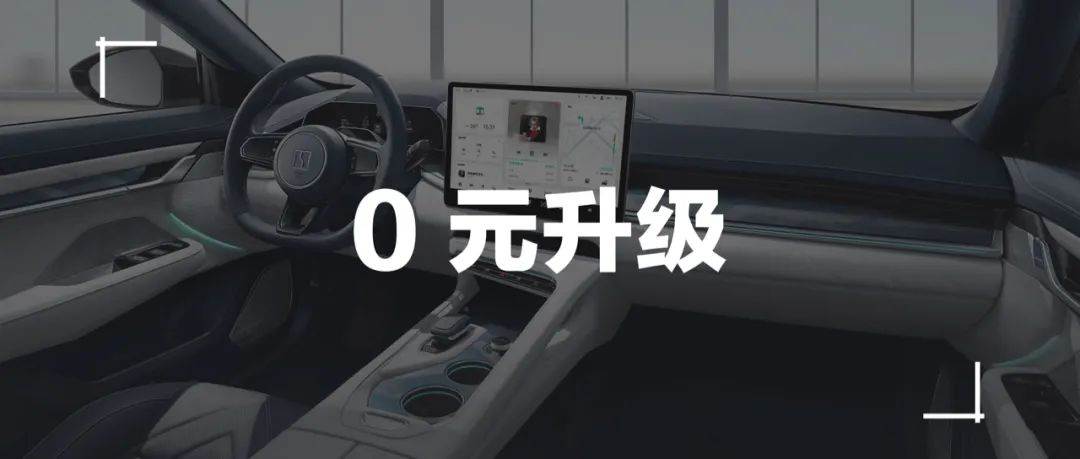Author: MuMin
On July 11th, the Geely JiKe 001 model received many updates, including the evolution of its intelligent drive, intelligent cockpit, and intelligent driving system, as well as the new Geely JiKe 001 ME model, which starts at 349,000 yuan.
The most important update is that the Geely JiKe 001’s intelligent cockpit computing platform has been upgraded from the previous Qualcomm Snapdragon 820A to the Qualcomm Snapdragon 8155 chip. Moreover, the entire cockpit software system will also be updated, and this whole software and hardware upgrade is free, setting an industry precedent.
A comparison can be made with NIO’s 866 car owners, who have to pay a fee of 9,600 yuan to upgrade their intelligent cabin system including the Qualcomm Snapdragon 8155 cockpit chip, while LanTu Free car owners also need to pay 4,999 yuan to upgrade to the 8155 chip.
In addition, Geely JiKe 001 has also added an intelligent Bluetooth key to solve the card key problem that Geely JiKe 001 car owners previously had, and the Bluetooth key is also free.
Zero cost upgrade of the cockpit chip and free smart Bluetooth key installation bring great benefits to the Geely JiKe 001 car owners, while also enhancing the reputation of Geely JiKe, and the cost of Geely JiKe’s research and development of the cockpit system based on the new platform is between 300 million and 500 million yuan.
From the current response, this is a cost-effective deal, and it further intensifies the internal competition within the intelligent electric vehicle industry.
Now let’s take a detailed look at what upgrades the Geely JiKe 001 has received.
Intelligent cockpit update: Qualcomm Snapdragon 8155 chip installation is free
Faced with the most user complaints about the Geely JiKe 001 car’s machine freezing and frequent operational problems, Geely JiKe finally brings the new intelligent cockpit computing platform Qualcomm Snapdragon 8155 for all new and old users to upgrade for free, followed by the brand-new Zeekr OS 3.0 software system version.
With the upgrade to the 8155 chip and software optimization, the new Geely JiKe 001 cockpit has significantly improved:
Firstly, the system speed is faster.
The machine wake-up time is 2 seconds, the machine cold startup speed has increased threefold, the slide frame rate has increased by 66.1%, and the average boot time of in-car applications is 1.3 seconds.
Secondly, the human-machine interaction is smoother.
114 icons have been optimized; a new slide-down control center has been added, with 18 high-frequency functions that can be customized; visible and speakable, with 70 new and optimized semantics and 11 voice packages to switch; in addition, the interaction of the intelligent capacitive touch steering wheel has also been upgraded.The cabin experience is now richer after the upgrade.
The upgrade includes switching the in-car map from Baidu Maps to Amap, adding Tencent’s AiQuTing and comprehensively upgrading its content. In addition, there has been an improvement in audio technology.
To achieve this upgrade of the intelligent cabin, JiKe reportedly invested over CNY 300 million in development costs, including software and hardware iterations. This time, JiKe is sincerely committed and decided to provide the upgrade for free to all users.
In terms of the cabin chip upgrade issue, why does NIO and Voyah charge for upgrades while JiKe doesn’t?
Let’s take “user enterprise” NIO as an example:
From the perspective of the car company, NIO has over 200,000 owners of the old 866 model, which is one order of magnitude more than JiKe 001’s owners (slightly over 20,000). If the upgrade is free, JiKe can handle it with RMB 300-500 million, while NIO would need to spend at least more than RMB 2 billion, as well as personnel and resource investments, which is difficult for the start-up company to bear.
From the user’s perspective, all users hope to be able to upgrade their cabin chips for free. However, NIO has been delivering cars for 4 years, while JiKe has delivered cars for less than 1 year.
Moreover, the 820A car infotainment system used in NIO has fewer problems compared to JiKe 001’s system, which has received numerous complaints. Updating and iterating product technology is a common practice, and consumers of smart cars need to gradually accept this point. If they cannot accept it, they can only choose not to upgrade or change cars.
Apart from these two perspectives, there are also technical and product perspectives.
The NIO 866 model was launched earlier and was a car from three to four years ago. It was built based on the NT1 platform. At that time, the Qualcomm Snapdragon 8155 was not as popular. The mainstream cabin chip at that time was the Qualcomm Snapdragon 820A, which was the only option for NIO at the time. If you look at the NIO NT2 platform cars now, they have all switched to the 8155 chip.
From the product perspective, the cabin experience of the NIO 820A model does not encounter significant user experience problems, as NIO has made many trade-offs and optimizations in its software. But the JiKe 001 cabin is different. Its system based on the 820A chip is slow and has poor user experience, which has been complained about extensively.
Therefore, the NIO 866 model’s cabin needs to go from average (820A) to excellent (8155), while the JiKe 001’s cabin needs to go from poor (820A) to excellent (8155). The starting points of the cabin system experiences of the two car companies are different.
Therefore, from all aspects, it can be understood that NIO charges for the cabin chip upgrade of the 866 model to improve the car infotainment experience, which can be understood, as the car owners can continue to use the cars without upgrading. Meanwhile, the JiKe 001’s cabin chip upgrade is completely free to solve the product issues, and to show appreciation to car owners and rescue their reputation.In any case, different condition and objectives lead to different strategies and pricing schemes for automakers.
According to Zeekr’s plan, their intelligent cockpit upgrade service will be available for reservation starting from August 1st this year. This time, there won’t be much need for disassembling components as the SEA architecture provides flexibility for the vehicle’s hardware update, which only requires dismounting a few screws, and the software upgrade takes roughly two hours.
Intelligent driving capability update
Before this, Zeekr’s 001 only had ACC as their advanced driving assistance system feature, which wasn’t quite remarkable in terms of performance. But this time, Zeekr has finally optimized ACC’s experience and added LCC’s lane-centering function.
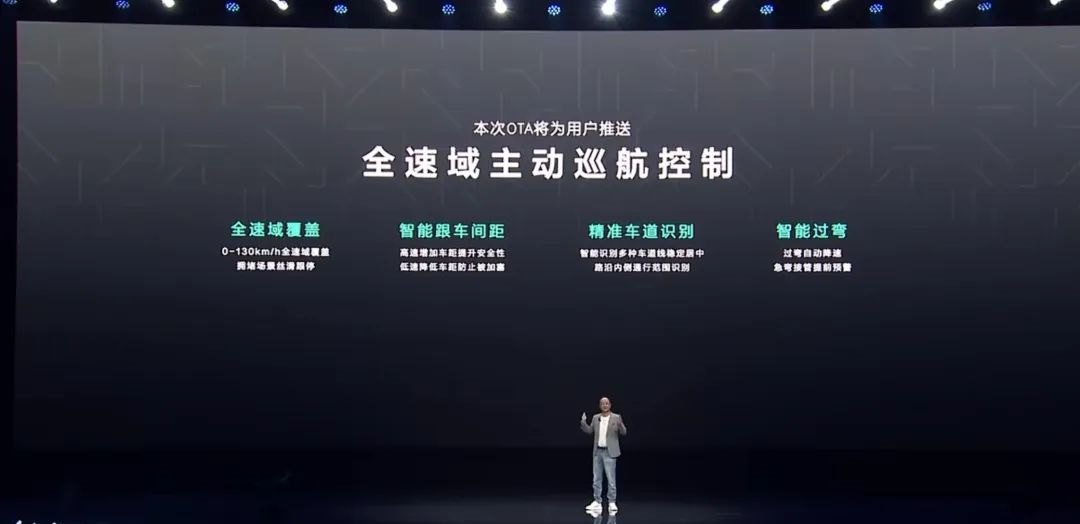
Zeekr has packaged this upgrade’s features into a full-range active cruise control system.
The specific features include:
- Full-range coverage: Full coverage from 0 to 130 kilometers per hour with better performance in congested and tailgating scenarios;
- Adaptive distance control: Self-adaptive adjustment of the following distance in high and low-speed scenarios;
- Accurate lane identification: Capable of identifying multiple types of lane markings and recognizing the coverage range of the interior road edges;
- Intelligent turning: Automatic speed limit reduction when turning and warning takeover in sharp turns.
In addition, Zeekr’s intelligent driving system for 001 has added special functions to respond to specific scenarios that are more prone to danger, such as pedestrian/stationary obstacle avoidance, large vehicle avoidance, and occupied lane avoidance.
Of course, the author is still looking forward to NZP’s update for Zeekr’s 001 navigation and advanced driving assistance system. Does this system, built with Mobileye EyeQ5 chips, have what it takes to be a market leader?
In an interview with the media, Zeekr’s VP of intelligent driving, Chen Qi (formerly the head of Huawei’s ADS product R&D department), said Zeekr’s strategy for autonomous driving system R&D is a dual approach of “self-research + supplier.” The supplier approach is to use Mobileye EyeQ5 chips and supporting Chinese ADAS companies like Zhixing Technology. Mobileye is also planning to fully support Zeekr’s project by setting up their Chinese R&D core team in Hangzhou Bay.
Currently, Zeekr’s autonomous driving team has nearly 500 members, with more than 100 people in the supply team and more than 300 people in the self-research team. At this stage, Zeekr is rapidly advancing its self-research for autonomous driving systems, and its self-developed systems can already handle automatic parking, NZP navigation assistance, and urban autonomous driving.On the other hand, Mobileye has made greater breakthroughs in the openness of the EyeQ series chips and will no longer maintain the previous “black box” supply mode. Especially for EyeQ6 and later chips, they will be more open and friendly to personalized development by car manufacturers. In the future, Zeekr will very likely follow up with mass production of the EyeQ6 chip.
Smart Drive Update
Thanks to Zeekr 001’s development based on the scalable SEA vast architecture, it has over 4000 API interfaces, 7 major core chassis controllers, and 33 smart drive hardware devices. Millions of lines of software realize the coupling and coordination of software and hardware.
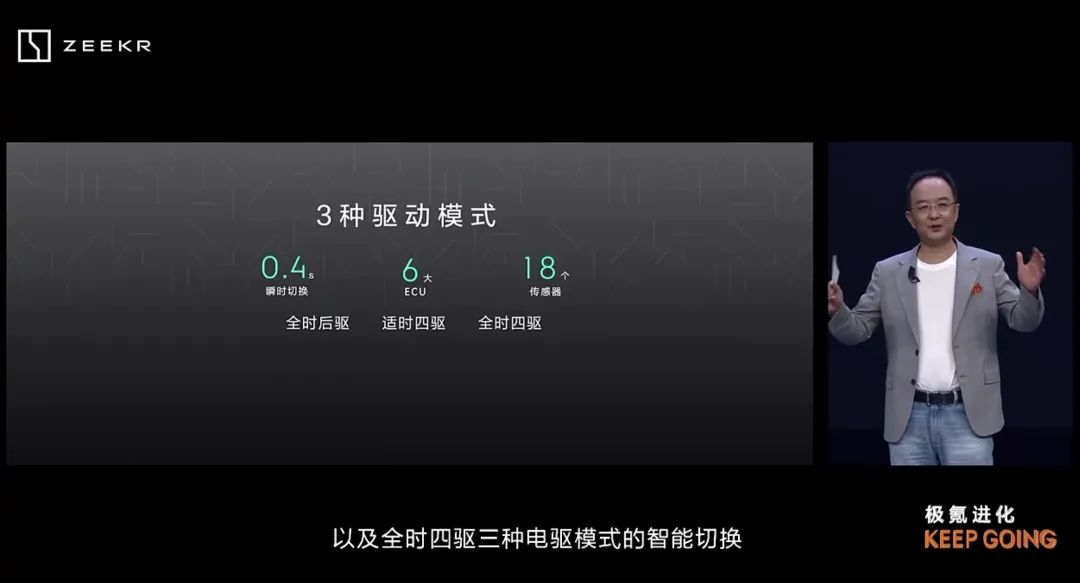
Therefore, this time, Zeekr 001 brings two important functions in the driving system: “lightning switching” and “intelligent anti-skid system.”
The so-called “lightning switching” means that Zeekr 001 can complete the switching of three driving modes in 0.4 seconds, requiring the coordination of 6 ECUs and 18 sensors to switch between full-time rear drive, adaptive four-wheel drive, and full-time four-wheel drive.
With the support of “lightning switching” technology, Zeekr 001’s CLTC comprehensive working condition range has been increased by 34 kilometers.
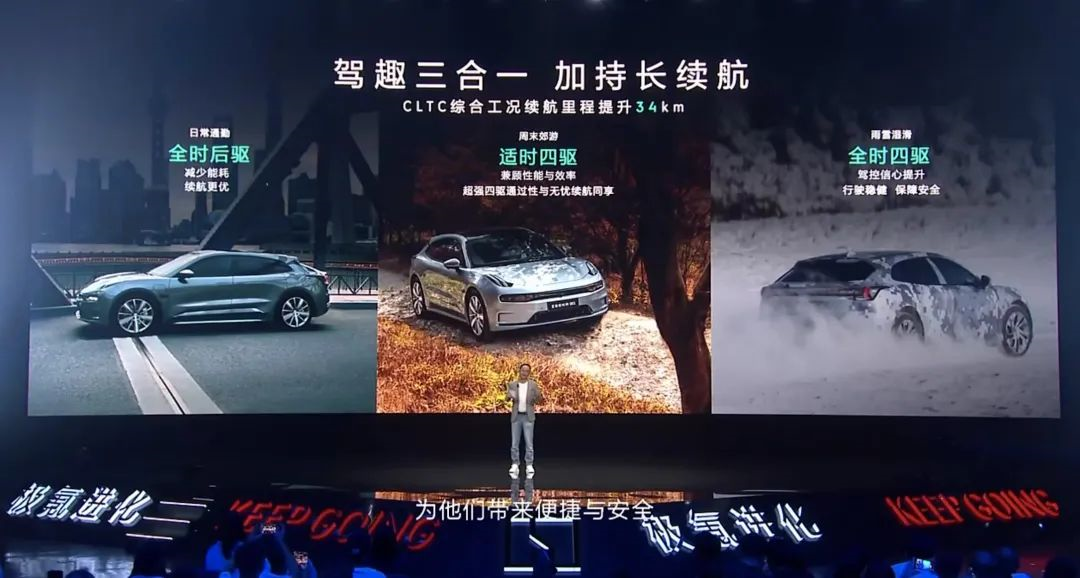
During daily commuting, switching to full-time rear-wheel drive can reduce energy consumption and optimize endurance. When going on a weekend outing, switching to adaptive four-wheel drive can balance performance and efficiency, and the vehicle’s passing and endurance performances can be achieved at the same time. On wet and snowy roads, switching to full-time four-wheel drive can improve driving confidence and make vehicle operation more stable.
The “intelligent anti-skid system” is easy to understand. This update can let users play drifting more safely. The acceleration time of a snow-covered vehicle from 0 to 60 kilometers per hour is 0.8 seconds faster, and the maximum controllable speed during extreme turning on ice and snow circles with a diameter of 200-250 meters is increased by 5-15 kilometers per hour. Of course, in daily life, few users will play drifting, but in icy, snowy, or rainy weather, this system can definitely improve driving safety.
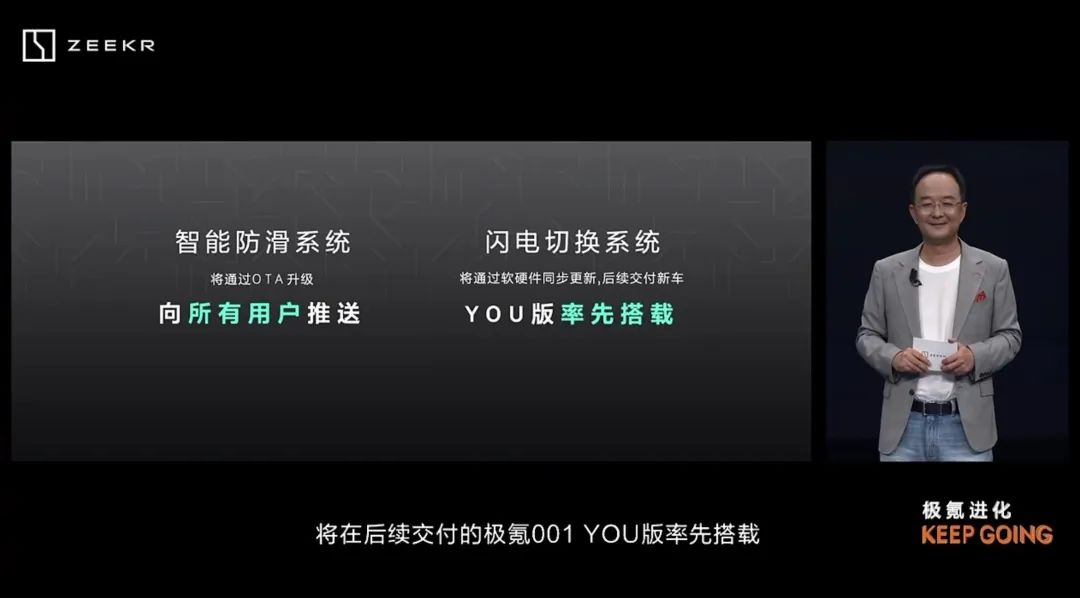 According to the plan of Zeekr, the “Intelligent Anti-slip System” will be upgraded to all users via OTA, while the “Lightning Switching” system will be updated to new cars delivered in the future through software and hardware synchronization. The new Zeekr 001 YOU edition equipped with these two new systems will maintain a starting price of RMB 386,000.
According to the plan of Zeekr, the “Intelligent Anti-slip System” will be upgraded to all users via OTA, while the “Lightning Switching” system will be updated to new cars delivered in the future through software and hardware synchronization. The new Zeekr 001 YOU edition equipped with these two new systems will maintain a starting price of RMB 386,000.
In summary, the entire set of updates of Zeekr, including Intelligent Drive, Intelligent Cabin and Intelligent Driving, will be fully pushed to Zeekr 001 owners with Zeekr OS 3.0. The push will start on July 19th, and users can experience their new Zeekr 001 in as little as one week.
Zeekr OS 3.0 includes Chassis Domain, Body Domain, Intelligent Driving Domain and Cabin Domain, involving updates to 25 ECUs, 29 new functions, and 204 user experience optimizations.
A New Model: Zeekr 001 ME Version
Zeekr has delivered over 20,000 cars in the past 200 days, during which many users have also put forward many personalized requirements. Therefore, in this update, Zeekr also brings a new model that better meets the needs of users: Zeekr 001 ME version.
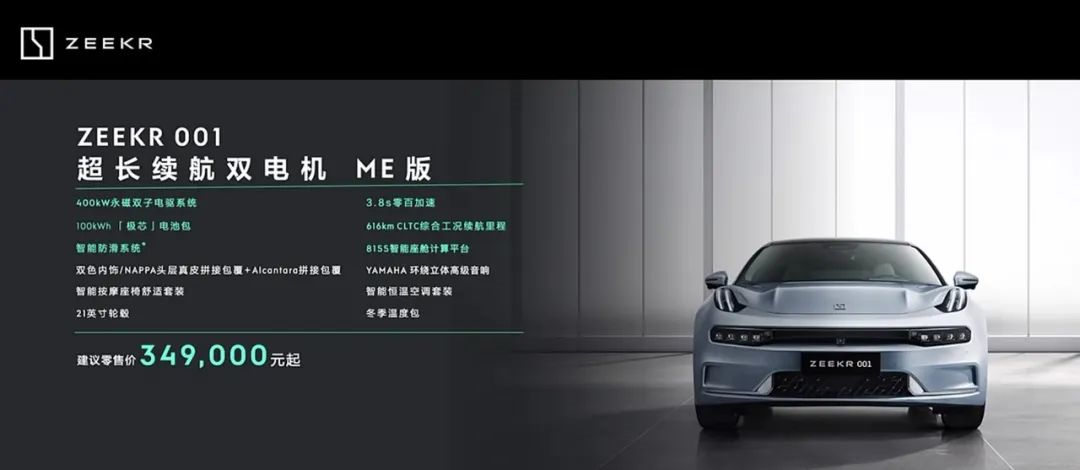
It can meet users’ needs for electric vehicle performance and endurance. In terms of performance, it has two 400 kW motors, and zero to one hundred acceleration of 3.8 seconds. In terms of endurance, it uses a battery pack rated at 100 degrees and can achieve 616 kilometers of comprehensive range under CLTC test conditions.
Moreover, this new model will also include the Intelligent Anti-slip System and the Qualcomm Snapdragon 8155 cabin chip, with a starting price of RMB 349,000.
With the launch of the new model, Zeekr will move towards a larger delivery target. In addition, Zhu Hui, the head of Zeekr, revealed that the average retention rate of the more than 20,000 Zeekr 001s delivered has reached 89.67%, but it has not yet been a year since the delivery of Zeekr 001.
So far, there are four models of Zeekr 001 for sale:
- Long-endurance Single Motor WE edition, starting at RMB 299,000;
- Long-endurance Dual Motor WE edition, starting at RMB 299,000;
- Long-endurance Dual Motor ME edition, starting at RMB 349,000;
- Long-endurance Dual Motor YOU edition, starting at RMB 386,000.
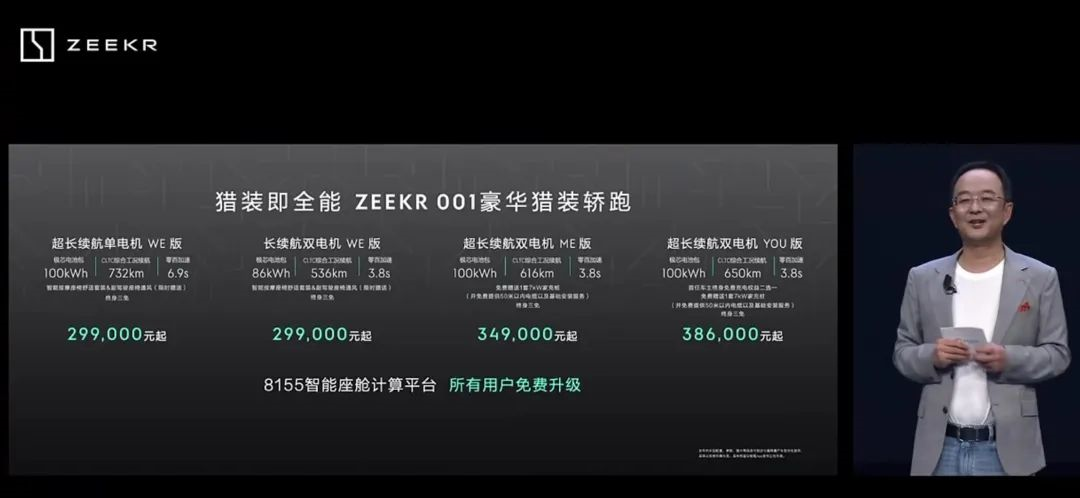
Can Zeekr 001, with its four models, win more consumers’ favor by taking advantage of this intelligent upgrade?
This article is a translation by ChatGPT of a Chinese report from 42HOW. If you have any questions about it, please email bd@42how.com.
